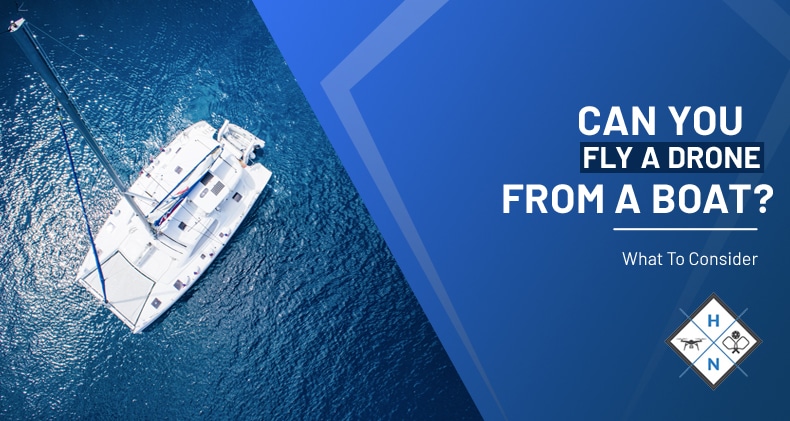There are no drone pilots, including commercial and recreational pilots, that have not visualized flying a drone from a boat. The fantasies and excitement to fly a drone over waters while getting footage of sights you will not see on an ordinary day.
Yes, you can fly a drone from a boat; the Federal Aviation Administration has no rule that forbids flying a drone from a boat. However, flying a drone from a boat is very different from flying a drone on land. It takes extra precaution, a great deal of care, and pre-consideration to fly safely.
While you are engrossed in the thought of flying your drone from a boat, all the beautiful sights you will capture and experience, you should know that flying a drone from a boat is not as easy as you envisioned it to be. Moreover, without the skill and expertise required, you can crash your drone into the waters.
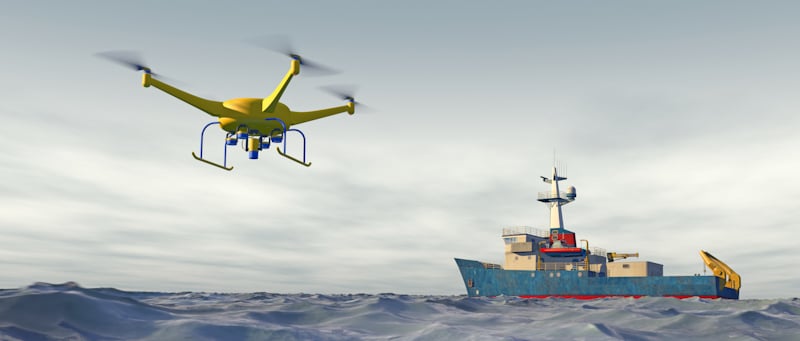
How do you launch a drone from a boat?
You will get a daunting experience when you fly your drone a boat, but it could also be costly and a waste of your investment. Hence the importance of understanding the safest way to fly your drone from a boat.
Before you dive into flying your drone from a boat, you must have a good number of years of experience flying a drone on land. Only skilled and experienced drone pilots can fly a drone from a boat without crashing it. As a new drone pilot, you need to perfect flying on land before flying from a boat.
For a test practice on how to launch a drone from a boat, you need someone to assist you because it is impossible to hold the drone and work the controls simultaneously. You must keep the rotors far above the person assisting you so it will be easy to reach and grab the drone.
It would help if you took caution and shut down the drone's rotors so the other person can firmly grip the drone; the rotors spin very fast and are very sharp. By failing to shut down the rotors, you are at risk of injuring yourself.
Until your assistant has a firm grasp on the drone, you must not shut down the motors; this prevents the drone from crashing into your assistant or the waters when flying the drone up and away from yourself.
It would be best to practice these on land for some time until you and your assistant have perfected it. Do not try practicing on a boat; you could crash your drone in the water, and the risk of getting your drone spoilt is very high.
It is easier for skilled and experienced drone pilots to launch their drone from a boat; they may not necessarily need another person to keep the drone steady. They have the skill and experience to keep it steady.
Nevertheless, the drone must be placed in a flat and stable place on the boat from which the drone will be launched. The place you choose to place your drone must be spacious, and you do not want your drone launching and crashing immediately into the sails, riggings, or any other obstacles.
As a skilled drone pilot, a GPS location must have been set on the drone, so as you launch the drone into the air, it could fly sideways until it is fully locked in the GPS position. During this time, the drone drifts; it will not crash into anything because of the adequate space.
Once you have launched the drone into the air, you must fly it away from the boat; the ocean or any body of water for that fact are unpredictable, so the boat could start rocking and swinging at any time, and you do not want to crash your drone.
From the two methods of launching a drone from a boat, you will notice that the best ways to launch for amateurs and experienced pilots are very different. An amateur pilot would need another person for assistance, but an experienced pilot would launch the drone by himself.
Tips For Flying Your Drone From A Boat
As mentioned earlier, flying a drone from a boat requires skill and expertise. Although it does not mean an amateur pilot cannot fly his drone from a boat, you can tell the difference with the drone's flight pattern.
Just before you start flying your drone from a bot, you should note the following things.
Understand The Specification Of Your Drone
Regardless of the skill or expertise as a drone pilot, you still need to understand your drone's specifications and functionalities. Every drone has its setting, and only a particular setting will be suitable for a flight over water. If our drone does not have that setting and you launch it from a boat, you could as well kiss your drone goodbye. You need to know the duration of the battery, the total flight time, and the distance. These are some of the things you must know before you fly from a boat.
Understand The Laws For Flying A Drone
One of the essential things to do before flying a drone in any location is to study the federal, state, and local laws regulating drones' flight. Different countries have different drone laws, and even states of a country could have different drone laws. Nevertheless, some laws are similar everywhere, laws like:
- You must not fly in the controlled airspace; your drone should be flown 400 feet from the ground.
- Your drone must be within a visual line of sight.
- You must not interfere with emergency activities.
- You must not fly your drone close to any critical infrastructure or transport systems.
These are laws that you will always find regardless of the country, state, or city you want to fly your drone. Although there are no formal laws that regulate flying drones from a boat, you still need to find out the laws. For example, flying drones could be banned from a particular city, and if you are caught flying from a boat, you could be fined and your drone confiscated.
Ensure you adjust your settings before flying
The first and second tips make the third tip of vital importance. The drone laws on maximum flight heights are reasons to set a maximum height attainable on your drone. However, these settings are dependent on the type of drone you have. It is advisable to learn the best setting to use on your drone before flying it. Some settings will make your drone fly in unfavorable conditions and, if not activated, could result in the drone taking much damage.
Prepare For The Flight Before You Fly Your Drone
Before you go off flying your drone either on land or from a bot, you must prepare yourself. You need to be aware of the surroundings if, on land, questions like, are there power lines nearby or high trees? Finding out these will make you prepared for any change in environmental conditions. Moreover, if you are flying your drone from a boat, you need to check the wind speed, the weather condition so you can be prepared instead of having your drone crashing into the mast of a boat or the sea.
Do Not Fly Your Drone In A Manner That Disturbs Other People
One vital thing to do is to respect other people around you. It is one thing to fly your drone in compliance with the Federal Aviation Administration drone laws, but when you are disturbing other people with your drone, you can be sued, and the outcomes will not always be pleasant. The same thing applies to when you are flying from a boat, do not use your drone to disturb people in other boats; you do not have to spy on others with your drone.
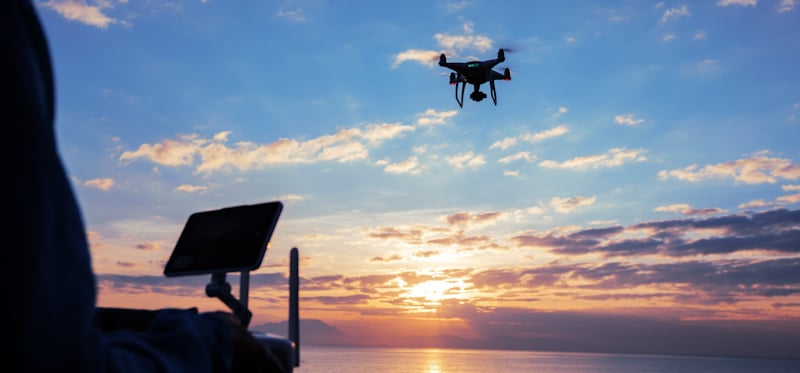
Take All Warnings Very Seriously
Every drone is programmed to make beeping sounds when there is an emergency. You must take note of these sounds so you can know what to do when flying your drone. You may not be aware that the drone's battery is low, but the beeping sound alerts you. Ignoring these warnings will only make you lose your drone to the sea. The moment you hear an unusual sound from your drone, you must be prepared to land it.
How To Fly Your Drone From A Boat Safely
We have continuously emphasized that flying a drone over water is very different from flying on land; the two environments have different potential hazards. When you fly on land, the potential hazards are tall trees, frequency interference, and lines, while on the water, the hazards are waves, high winds, birds, and other boats. Moreover, this is the main reason first-time fliers should not fly over water.
Disable The Vision Positioning System
Many drones are developed with a vision positioning system (VPS), and it helps position the drone by mapping the surface below. The light reflecting off the water's surface when flying over water can cause interferences with the VPS.
To ensure there is no interference, it is advised to fly your drone at the height of at least 2 meters from the water surface. However, if you intend to fly lower than this, you need to disable the VPS to prevent the drone from being unstable during flight. You should know that the minimum height you can fly your drone above the water surface is 1 meter.
Make Adequate Plans For Your Shot
As mentioned earlier that adequate planning is essential in having a successful flight over water. Planning prepares you for any possible hazards; in planning, you are also developing a contingency plan to fall back to if there is an emergency. You must also find the perfect location; you must have visualized the image or video you want to capture; this will reduce the amount of time spent over the water.
Avoid Obstacles During Flight
You will encounter many obstacles when flying your drone over water, and they can be hazardous to your drone. Any object or structure that can interfere with the GPS signal or compass of your drone, including lighthouses, boats, cruise ships, container ships, or any device with Wi-Fi, magnets, or antennas, should be avoided.
Natural structures like rocks and trees should also be avoided, as well as birds. Birds like seagulls are known to be very aggressive when they encounter drones. It would help if you also avoided waves, especially when flying too close to the water's surface.
Make Use Of The Intelligent Flight Mode
Drones like the DJI series are equipped with an impressive feature known as the intelligent flight mode, and it allows a drone pilot to create professional-level aerial footage with a tap. There are many modes, but one vital one is the Course Lock, and it enables you to preset a flight pattern. So, the drones can fly automatically without you controlling them.
Be Wary Of Wind Speed
Experienced drone pilots know that strong winds affect the stability of a drone during flight. Moreover, the drone's battery levels drop faster as the wind becomes more vigorous. Although it is almost difficult to avoid winds, the wind gets stronger as you fly higher. Nevertheless, here is a piece of advice, if you notice strong winds before launching your drone, delay your flight as the wind may be more vigorous as you fly higher.
A little carelessness is enough to get your drone damaged or lost when flying over waters, and this is why only experienced drone pilots should attempt flying over water. Nevertheless, if you abide by these tips, you are sure to have a hitch-free flight over water.
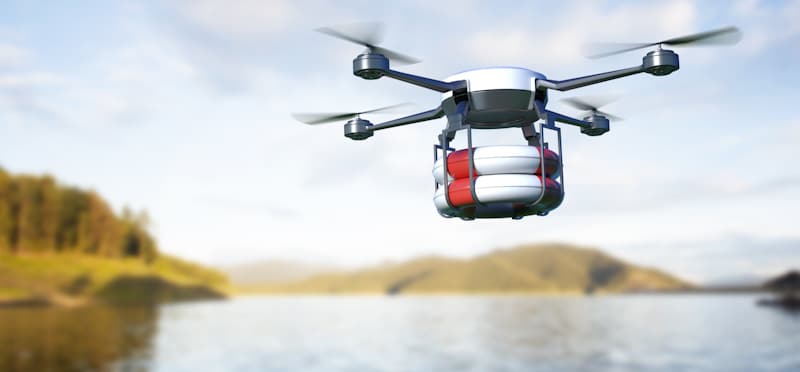
Best Drones For Flying Over Water
Choosing a drone to fly over water can be confusing, especially as a person with little experience with drones. Do not worry; we have you covered; below is a list of the best drones that can fly over water without any issues.
DJI Mavic Pro
The DJI Mavic Pro is one of the best drones you can use over water, and it has a compact and foldable design, a total flight time of twenty-seven minutes, a charging time of 50-70 minutes, and a top speed of 40mph.
There are many additional features available in the DJI Mavic Pro, features like the independent flight mode that creates a preset flight path for the drone. There is also a front collision detection feature that makes the drone avoid crashing or colliding with objects.
This drone has two batteries, so you always have an extra if the first battery runs low. It also has an app where you can program everything on the drone, from the flight paths to the controller's button, battery allocations, and sound signals.
Parrot Bebop 2 Power FPV
The Parrot Bebop 2 Power FPV is an update of the original Bebop 2 drone, and it has some upgraded functionalities. The drone has a battery life of 30 minutes, hence the addition of "Power" to the name.
The drone has two batteries, automated shot modes like the "Follow object tracking," which makes you lock the drone onto an object, and the drone follows the object's path. This feature makes it an excellent choice to fly over water.
Parrot Mambo
One of the cheapest drones you can purchase is the Parrot Mambo, a mini drone that weighs just 2.22 ounces. As small as this drone is, it has some impressive specifications; a flight time of 10 minutes, a charging time of 90 minutes, a total flight speed of 18mph, and a controller range of up to 100 meters.
The controller's range controller range makes it suitable for pretty long flights but is small, and strong winds can destabilize it. The advantage of the size is it is effortless to maneuver between obstacles and obstructions.
DJI Spark
Another small drone with excellent capabilities is the DJI Spark, with a total weight of 0.66 pounds; it is equipped with a 12MP 1080p camera for photos and videos. It also has a gimbal of 2-axis and stable footage, so you are assured of excellent video quality. The minimum shooting range is 2 meters; the ISO has a range of 100 to 1600 for photos and 100 to 3200 for videos.
It is one of the best drones to fly over water as there are various flight and video modes you can choose from, modes like the ActiveTrack, enabling you to make a target on a moving object and trail it. Another mode is the QuickShot; the DJI Spark drone locks onto an object and executes series of programmed flight patterns.
The drone has a standard feature, which propels the three commands: the app control gestures, the remote control gesture, and the advance control gestures. So, you can even control the drone with hand gestures.
GoPro Karma
The GoPro Karma is the first drone produced by GoPro that is almost flawless compared to previous models. There have been many updates that have improved the flight, and there are also different automated flight modes.
The drone is straightforward to fly, and beginners will not have trouble flying this drone; it is launched with the push of automatic take-off and landed button. The drone delivers an ultra-bright, real-time, first-person view during flight.
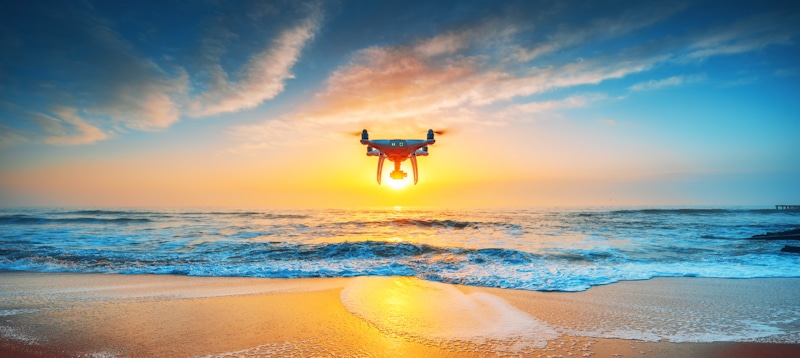
Final Thoughts
Flying your drone from a boat is an exciting adventure most drone pilots wish to experience, but they do not know how to go about so they may not have the opportunity of trying it out.
While anticipating the first time you will fly a drone from a boat, you need to pay attention to little vital things, like the laws of the location, the best drone you can use, and other things listed in this article. Otherwise, you might have your expectations cut short when your if your drone collides with the water or any objects that might be around, or runs out of juice.
Shawn Manaher loves to play with new toys and dive into new hobbies. As a serial entrepreneur, work definitely comes first but there is always room for hobbies.

